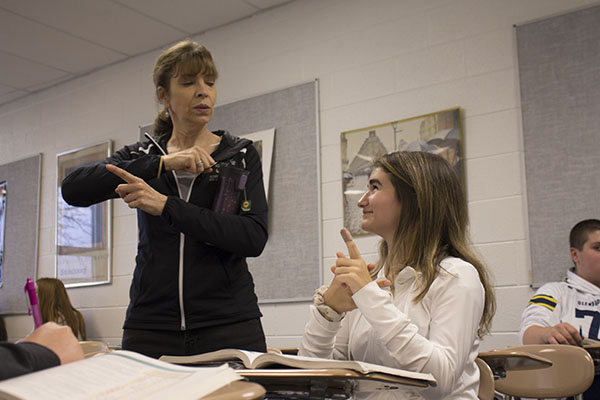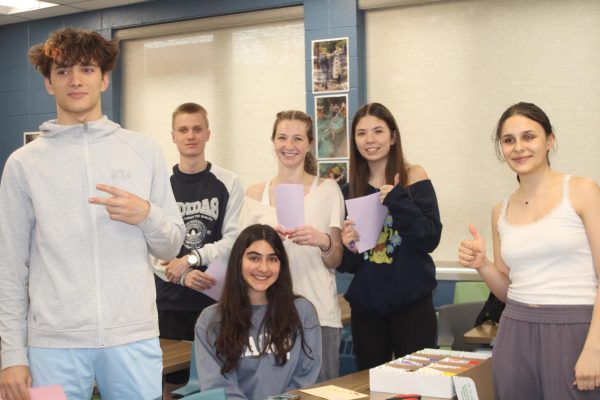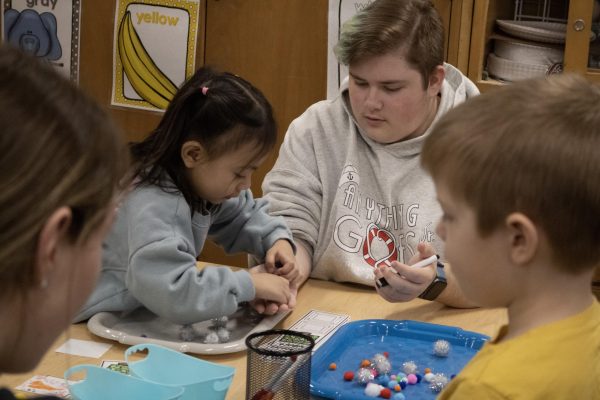ASL course promotes inclusion

SIGNS THAT SHINE: Demonstrating a new sign, Rosemarie Carsello, American Sign Language teacher shows sophmore Kendall Grenolds a new phrase in sign language. The American Sign Language class participates in events like Silent Weekend in order to immerse students in Deaf culture.
May 25, 2018
Under the ambient lights, the orchestra starts to play a slow, melodic tune as students of all grades and backgrounds stand throughout the auditorium, their hands rising elegantly to sign these four words: Let there be peace. Surrounding the audience, American Sign Language (ASL) students gathered together on the day of the annual Winter Assembly to interpret the song “Let There Be Peace on Earth” into sign language. All were well-equipped with smiles full of pride and joy, showing passion and dedication to the language.
According to ASL Teacher Rosemarie Carsello, the ASL course was created in 1998 and has offered its students more opportunities to invest deeper into the language since then. This included the creation of higher levels, as well as the addition of a second ASL teacher, Julie Santoro, who has been working at South for four years. Both teachers expressed their hopes that their students would become more aware of Deafness.
“I feel that the most important thing is the exposure, and to [allow students to] see something from a different perspective,” Carsello explained. “I think what we try to [spark in students is] ‘Oh I never thought about it before,’ because our culture is a hearing culture. We grew up as hearing people, so unless you’re given those opportunities to think about what it would be like to be a deaf person in a situation, you most likely wouldn’t.”
To promote student involvement in the Deaf community, ASL students are required to visit a Deaf event or a Deaf social gathering of their choice and reflect on their newly gained experience afterwards in a paper and a small presentation, according to Carsello and Santoro. Junior Dylan Ward has been taking ASL for three years and attended Silent Weekend, a silent social gathering of both hearing and deaf signers, which he believes yielded memorable experiences.
“At the typical Deaf events, you meet a lot of adults that know sign language, but my friend and I met three girls [at Silent Weekend],” Ward shared. “Two of these girls were hearing, one became deaf three years ago and the two girls took ASL to support her. I thought that was memorable because it’s a little bit different when you meet a person who is deaf and is your age. You can relate to them more, especially since she was born hearing and lost [it three years ago].”
Along with Deaf events, ASL students are also required to take part in the annual Silent Day at South in which students take a vow of silence. They promise to sign from the moment they wake up until 8 p.m. According to freshman Morgan Trauscht, who has taken ASL for one year, while her first Silent Day was a challenge, it opened her eyes to what deaf people might face on a daily basis.
“During my after school activity, my [skating coach] yelled at me that signing or trying to teach other people ‘excuse me’ and ‘watch out’ [in sign language] could be a distraction, because I wasn’t allowed to speak,” Trauscht said. “So it was very terrifying to skate without a voice. You can see how some people might see [being deaf] as a negative thing, and how some people react to it differently.”
In addition to these activities, students are also given the opportunity to go on several field trips throughout the year based around personally experiencing Deaf culture and community, according to senior Eliana Wright, who has been taking ASL for four years. Wright shared one field trip in which South’s ASL students went to visit Pen Pals from students of a school with an integrated Deaf program and watch a theatrical performance by them.
“It was very cool to see everyone at a school involved in the ASL program” Wright said. “When I looked around in the audience, everyone was shaking their hands, and no one was clapping at all, and I thought that was really special because even though they don’t take ASL, they’re still involved in it … and it’s so widely [integrated] in their school.”
Due to her passion and enthusiasm for the language, Wright is looking into creating an ASL Club at college when she attends Creighton University this fall. Wright has expressed her love for ASL throughout her time at South, as shown by her signed performance in this year’s Variety Show. Although she was nervous, she kept in mind her love for the language and what she stood for when signing on stage, according to Wright.
“I think remembering that I could do it and remembering that I’m showing both deaf people and hearing people that [ASL] is a language that should be taught in every school [helped a lot when I was performing],” Wright said.
For some students like junior Erin Rosenfeld, the ASL experience has been one of learning that has helped her reflect on her identity. Unlike the majority of ASL students at South, Rosenfeld is a GBN student who drives to South from GBN to take the course every Gold day.
“Being hard of hearing, I’ve always felt like I didn’t belong in the hearing world but I also didn’t belong in the Deaf world,” Rosenfeld said. “So, a big takeaway for me [from taking ASL] is that I can be apart of both. [I’ve learned] that you don’t have to restrict yourself to one world. You can communicate with whoever you want.”













